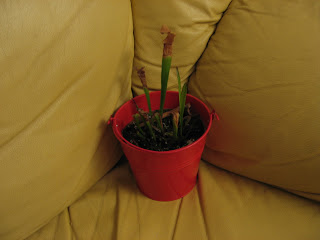Saturday, 26 March 2011
Meet The Frog
Not exactly garden-related subject today, but a plant is a plant.
Let me share with you another one of my tiny fixations - developing passion for carnivorous plants.
The one on the picture belongs to pitcher plant family, I'm not even exactly sure what species it is and I'm not that keen on finding out. As long as it survives and catches flies, I don't care too much about it's identity.
I name all of my houseplants, at least those that are not supposed to be eaten at some stage, but to stand there and look pretty. So my shelves are graced by Troll, Tiger, Frog and, until recently, a rose named Lasarus. Lasarus got cut down and tended to grow back (hence the name) but one day it simply refused to resurrect. No harm done, its pot immediately got recycled as a growing space for dill.
The Frog, as you can probably imagine, got its name from its habits. Just like the green, croaking creatures, it catches and consumes flies. I also have a soft spot for the word itself, one day, for no reason at all, I started collecting words for 'frog' in all the languages I could and I must have gathered something about 30 now. The more exotic pearls from my collection include Welsh, Finnish, Afrikaans, Suahili, plus the whole load of European languages with which I am most familiar. If you happen to know some frogs that could enrich my collection, please, please, please email me!!!
Back to the plant, though.
I got it as a present some time last autumn, and it wasn't long before the pitchers started to dry off. I attacked local florists for information on how to care about it. As it usually happens, no two people seemed to agree on the correct way of making a carnivorous plant survive. One lady told me it should be kept in very wet environment, as in the wild it grows mostly on bogs and marshes. I increased the amount of water given to the plant, but no joy, the leaves kept going brown.
Only after a while I found out that this type of plants basically goes to sleep in winter. If you grow it outside, simply leave it out there (unless there's really sharp frost, in which case the plant needs to be covered with something to protect it from the cold) and it will grow back in the spring. But what if your plant lives indoors?
I browsed the Internet, but no option seemed right for me. People suggested tool sheds, cellars etc, and I simply don't have use of such places. Someone even advised to wrap it up in something wet and store away in the fridge. Imagine that! No, I couldn't do such a thing to my Frog.
My good fairy of this story appeared to me as another florist lady, who finally gave the advice that worked. She told me to significantly cut down on watering and to water it only with warm water.
You know what? It worked! Frog survived the winter. You can see for yourself that she still doesn't look like much, there's still those dry bits all over the place, but recently she started sprouting new green leaves and now she seems to show even more with every day. Hurra!
Oh, and as for the more meaty diet? I was pretty disappointed to see that it takes her weeks to digest even the smallest fly. It's also not so keen on hunting herself, so sometimes I throw her an odd fly that pisses me off once too many. She even got a tiny bit of sausage the other day (not inside the pitcher! On the ground!). Seemed to like it :).
Subscribe to:
Post Comments (Atom)

No comments:
Post a Comment